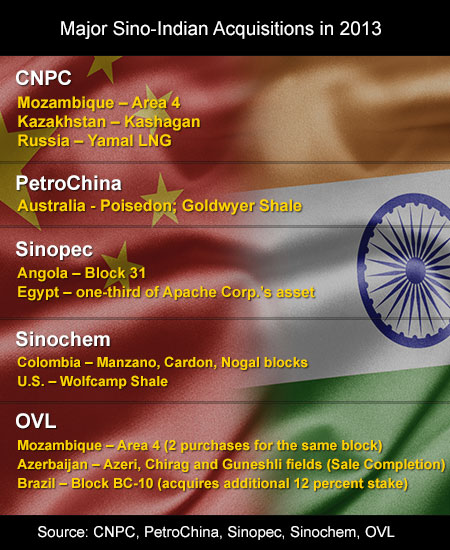Sino-Indian Rivalry Intensifies over Petroleum Resources Overseas

China and India have actively scoured the planet in their quest to secure hydrocarbons to meet rising domestic energy demand. With few attractive upstream assets available around the world, it is perhaps inevitable that both countries would increasingly end up bidding for the same blocks. Such an outcome only serves to heighten the stakes for the two Asian giants as they attempt to ensure a steady flow of hydrocarbons for their respective countries.
Driver for Foreign Upstream Acquisitions
For over a decade, China and India have ventured overseas to search for upstream oil and gas assets, driven by the need to meet rising domestic energy demand resulting from strong economic growth. From 1990 to 2010, China’s economy grew by an average of 10.4 percent annually, while India posted 6.4 percent, the U.S. Energy Information Administration (EIA) reported. In 2012, economic growth in China and India stood at 7.2 percent and 5.5 percent, respectively.

Rising economic growth was reflected in higher energy consumption and China and India ranked as the world’s second and fourth largest consumer in 2011. Chinese oil demand in 2012 reached 10.22 million barrels of oil per day (MMbopd), almost doubled the 5.26 MMbopd consumed in 2002, while India’s consumption grew 51 percent to 3.65 MMbopd from 2.41 MMbopd in the corresponding period, figures from BP Statistical Review of World Energy 2013 indicated.
Oil imports have grown increasingly important in both countries as domestic production could not cope with rising demand. China imported 5.43 MMbopd of crude oil in 2012, while India’s imports reached 3.54 MMbopd. China’s oil consumption is poised to increase 420,000 barrels of oil per day (bopd) in 2013 and a further 430,000 bopd in 2014, compared to 510,000 bopd from 2003 to 2012, EIA estimated in its Short-Term Energy and Winter Fuels Outlook released Oct. 8.
China’s dependence on imports reached a new milestone in September when it bought 6.3 MMbopd to overtake the United States’ 0.2 MMbopd and become the world’s largest oil importer, the EIA's Short-Term Energy Outlook said.
“China’s steady growth in oil demand has led it to become the world’s largest net oil importer … EIA forecasts this trend to continue through 2014.”
On natural gas, China’s imports also grew substantially, reaching 1,108 billion cubic feet (Bcf) in 2011, up from 33 Bcf in 2006. India’s import demand doubled in the same period from 282 Bcf to 579 Bcf, data from the U.S. Energy Information Administration (EIA) showed.
Imports comprised 22 percent of China’s total natural gas consumption in 2012, compared to 12 percent in 2010. With China boosting the use of natural gas to mitigate the impact of pollution arising from its heavy use of coal and to diversify the fuel mix in the domestic sector, the country’s annual gas demand is set to climb to 11 trillion cubic feet (Tcf) by 2035, EIA said, adding that to “meet this demand, China is expected to continue importing natural gas.”
India was the world’s sixth largest liquefied natural gas (LNG) importer in 2011, accounting for over 5 percent of the global market, EIA said using statistics from PFC Energy. LNG imports made up a quarter of India’s total gas demand of 2.3 Tcf in 2011 and foreign supplies are set to rise further as India’s Oil Ministry expected local gas demand to double in the next five years.
Major Sino-Indian Acquisitions in 2013
Given the high costs of upstream hydrocarbon assets, efforts to secure them have generally been led by state-owned companies, particularly in China, which has historically been more active in foreign upstream acquisitions than their India counterparts. The Chinese acquisition drive is also supported by the country’s huge foreign exchange reserves, which the People’s Bank of China put at $3.66 trillion as at Sept. 30.
“China has more advantages … the Chinese government is richer than the Indian government and can subsidize overseas activities ... to diversify supply of oil resources,” Zhao Hong, senior research fellow at East Asia Institute at the National University of Singapore (NUS) told Rigzone.
Like China, Indian companies are encouraged to diversify their supply sources by securing more overseas energy assets, which in the case of state-owned Oil and Natural Gas Corporation (ONGC), meant seeking major acquisitions beyond Sudan and particularly Russia’s Sakhalin. The government also prompted Indian companies to buy these assets to help insulate the country’s energy sector from global oil and gas price volatility.
China’s Upstream Purchases
PetroChina, China’s largest state-owned energy company China National Petroleum Corp. (CNPC), started the year by acquiring assets in Australia. The company took a 20 percent stake in the Poseidon block in the Browse Basin and a 29 percent interest in the Goldwyer Shale block in the onshore Canning Block in February. Its parent company CNPC paid $4.21 billion to Eni SpA in March for 20 percent interest in Area 4 gas block, located offshore Mozambique in the Rovuma Basin.
CNPC made a bigger investment in September, paying $5 billion to purchase 8.33 percent interest from KazMunaiGas – Kazakhstan state oil and gas firm – in the offshore Kashagan oil project in the Caspian Sea. The deal dashed the hopes of ONGC – through its overseas upstream subsidiary ONGC Videsh Ltd. (OVL) – participating in the Kashagan project after the Indian company had agreed to take over ConocoPhillips’ share of the development in November 2012. ConocoPhillips’ stake in the Kashagan project was bought by Kazakhstan after the government decided in July to exercise its pre-emptive right to buy the 8.33 percent, which it eventually sold to CNPC.
In the same month, CNPC also signed an agreement to acquire 20 percent share of the Yamal LNG project from Russia’s OAO Novatek. Gas supply for the project will come from the South-Tambeyskoye field.
Meanwhile, China Petroleum & Chemical Corp. (Sinopec) participated in two major upstream acquisitions in Africa. The Chinese firm agreed in June to pay $1.52 billion to Marathon Oil Corp. for 10 percent interest in the producing Angola Block 31 oil field. The company then acquired a one-third stake in Apache Corp.’s Egyptian oil and gas business for $3.1 billion in August.
Another major Chinese energy firm, Sinochem Corp., bought 50 percent equity each of Manzano, Cardon and Nogal blocks in the Caguan Basin, Caqueta Province in Colombia from Ecopetrol S.A. in May. In February, the firm bought a 40 percent stake in the Wolfcamp Shale assets in the Permian Basin in West Texas, U.S. from Pioneer Natural Resources Co. for $1.7 billion.
However, Sinochem’s planned acquisition of a 35 percent interest in Block BC-10 in the Campos Basin off Brazil from Petroleo Brasileiro S.A. (Petrobras) in August for $1.54 billion encountered a setback. Two existing stakeholders in Block BC-10 – India’s OVL and Royal Dutch Shell plc – exercise their pre-emption rights Oct. 11 to purchase Petrobras’ 35 percent stake in the producing deepwater oil development. OVL paid $529.03 million to bring its interest in Block BC-10 to 27 percent.
India Not Sitting Still
The CNPC acquisition in Area 4 gas block in the Rovuma Basin in Mozambique was followed in June, when OVL and its partner Oil India agreed to purchase 10 percent interest in Area 1 gas block – also in the Rovuma Basin – from Videocon Mauritius Energy Ltd. for $2.475 billion. OVL took a further 10 percent stake in the same block in August by paying Anadarko Petroleum Corp. $2.64 billion.
The Indian company completed in February a $1 billion acquisition of Hess Corp’s 2.7213 percent participating interest in the Azeri, Chirag and the deepwater portion of Guneshli fields in the Azerbaijan sector of the Caspian Sea and 2.36 percent interest in the Baku-Tbilisi-Ceyhan Pipeline. The acquisition is consistent with OVL’s “strategic objective of adding high quality international assets to its existing exploration and production portfolio and also bears significant strategic importance to India,” the firm said in a September 2012 press release.
Competition or Cooperation
Chinese and Indian state-owned energy firms have already crossed paths this year in Kazakhstan and Brazil over the Kashagan and the BC-10 oil projects, respectively. It is uncertain where and when such an eventuality will again take place.
Chinese firms currently hold the upper hand in the contest for foreign overseas upstream assets. They have ample financial resources to tap on and receive strong government support in negotiations for such deals, including the provision of non-energy related development projects in return for upstream petroleum assets.
“Many overseas resources [including energy] projects are related to infrastructural projects … which Chinese companies can offer … this is an advantage that India does not have,” Zhao said, referring to the construction of infrastructure such as roads, ports, etc.
To diversify its supply sources, Indian state-owned energy companies are expected to proactively scout for attractive upstream assets, including in resource-rich Africa and Brazil, places that China is also interested in.
“For over a decade, India’s investment in Sakhalin did not work out that well … it was the same in Myanmar,” S Narayan, Head of Research and visiting senior research fellow at the Institute of South Asian Studies, NUS told Rigzone, adding that may be “why ONGC is becoming more active in Africa and Brazil.”
Indian state-owned energy firms like OVL could get assistance to overcome financial constraints they faced when buying foreign upstream assets, “if necessary, the government will help raise bonds for the acquisitions,” Narayan said.
Meanwhile, future cooperation on upstream asset acquisitions between Chinese and Indian state-owned energy firms cannot be completely ruled out, especially if there is a convergence of interest between both these large petroleum importers.
WHAT DO YOU THINK?
Generated by readers, the comments included herein do not reflect the views and opinions of Rigzone. All comments are subject to editorial review. Off-topic, inappropriate or insulting comments will be removed.
- Malaysia's InvestKL Woos Top Oil, Gas MNCs to Base in Kuala Lumpur
- Petrobangla Invites EOIs for 3 Offshore Exploration Blocks in Bay of Bengal
- Malaysia's SapuraKencana Posts 7.1% Gain in 2Q FY17 PAT to $27M
- TH Heavy Engineering, McDermott End Partnership in Malaysia
- Singapore's NUS Slowly Builds its Petroleum Engineering Program
- USA Regional Banks Dramatically Step Up Loans to Oil and Gas
- An Already Bad Situation in the Red Sea Just Got Worse
- Oil Markets Were Already Positioned for Iran Attack
- Valeura Makes Three Oil Discoveries Offshore Thailand
- EU Offers $900MM in Funding for Energy Infrastructure Projects
- Germany to Provide $2.3B Aid for Decarbonization of Industrial Sectors
- North America Breaks Rig Loss Streak
- Chile's ENAP Says Working on Decarbonization Plan
- Mexico Presidential Frontrunner Plans to Spend Billions on RE, Gas Power
- ExxonMobil French Unit to Sell Refinery to Entara-Trafigura Consortium
- Macquarie Strategists Warn of Large Oil Price Correction
- JPMorgan CEO Says LNG Projects Delayed Mainly for Political Reasons
- USA, Venezuela Secretly Meet in Mexico as Oil Sanctions Deadline Nears
- EIA Ups Brent Oil Price Forecast for 2024 and 2025
- Petrobras Discovers Oil in Potiguar Basin
- EIR Says Oil Demand Will Not Peak Before 2030
- Biden Plans Sweeping Effort to Block Arctic Oil Drilling
- Pantheon Upgrades Kodiak Estimates to 1.2 Billion Barrels
- Dryad Flags Red Sea 'Electronic Warfare' Alert
- USA Crude Oil Stocks Rise Almost 6MM Barrels WoW
- Oil and Gas Executives Predict WTI Oil Price
- New China Climate Chief Says Fossil Fuels Must Keep a Role
- Chinese Mega Company Makes Another Major Oilfield Discovery
- Oil and Gas Execs Reveal Where They See Henry Hub Price Heading
- Equinor Makes Discovery in North Sea
- ExxonMobil Racks Up Discoveries in Guyana Block Eyed by Chevron
- Macquarie Strategists Warn of Large Oil Price Correction
- DOI Announces Proposal for Second GOM Offshore Wind Auction
- Standard Chartered Reiterates $94 Brent Call
- Chevron, Hess Confident Embattled Merger Will Close Mid-2024


